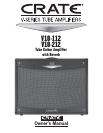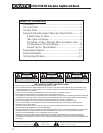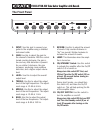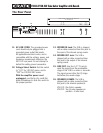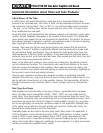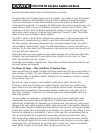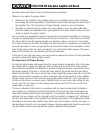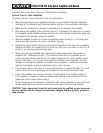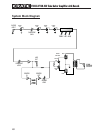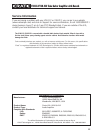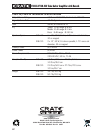
V18-112/V18-212 Tube Guitar Amplifier with Reverb
7
The power tubes are the largest tubes used in an amplifier. These tubes convert the low-level,
conditioned signal from the preamplifier into a level that is sufficient to drive the speakers.
There are several types of power tubes available, each of which offers a different perfor-
mance/sound characteristic. For example, the EL34 power tube produces a great classic rock
sound. When an EL34 is driven into distortion, it produces a unique sound (“crunch”). When
compared to the 6L6, the EL34 distorts more quickly, exhibits a “looser” low-end response
and produces more harmonics at mid and high frequencies (“creamier” sound). These differ-
ences become more noticeable at higher volumes.
The EL84 is similar to the EL34 but produces less output power. It can be easily driven into
distortion and is characterized by a smooth, sweet tone with excellent touch sensitivity.
6L6 tubes produce a big low-end thump and have a very good dynamic range. They offer a
more traditional “American Rock” sound. The 6V6 tubes produce a creamy sound with nice
distortion. On the other hand, the KT88 produces a big low-end but sounds more like an EL34
in the mid and high frequencies.
6550 power tubes are more rugged and stay cleaner-sounding even at full power. When they
do distort, the sound produced is more solid and has a tighter low end; more of a “heavy
metal” type distortion with lots of power.
Some tubes are available in matched sets. These tubes have been extensively tested for opti-
mum performance and longevity.
The Nature Of Tubes — Why (And When) To Replace Them:
Tubes are made up of a number of fragile mechanical components that are vacuum-sealed in a
glass envelope or bubble. The tube’s longevity is based on a number of factors which include
how hard and often the amplifier is played, vibration from the speakers, road travel, repeated
set up and tear down, etc.
Any time you notice a change in your amplifier’s performance, check the tubes first.
If it’s been a while since the tubes were replaced and the sound from your amplifier lacks
punch, fades in and out, loses highs or lows or produces unusual sounds, the power tubes
probably need to be replaced. If your amplifier squeals, makes noise, loses gain, starts to
hum, lacks “sensitivity”, or feels as if it is working against you, the preamplifier tubes may
need to be replaced.
The power tubes are subjected to considerably more stress than the preamplifier tubes.
Consequently, they almost always fail/degrade first. If deteriorating power tubes aren’t
replaced they will ultimately fail. Depending on the failure mode, they may even cause severe
damage to the audio output transformer and/or other components in the amplifier. Replacing
the tubes before they fail completely has the potential to save you time, money and unwanted
trouble. Since power tubes work together in an amplifier, it is crucial that they (if there is more
than one) be replaced by a matched set. If you’re on the road a lot, we recommend that you
carry a spare matched set of replacement power tubes and their associated driver tubes.
After turning off the power and disconnecting the amplifier from the power source, carefully
check the tubes (in bright light) for cracks or white spots inside the glass or any other appar-
ent damage. Then, with the power on, view the tubes in a dark room. Look for preamplifier
tubes that do not glow at all or power tubes that glow excessively red.
Important Information About Tubes and Tube Products (continued):



